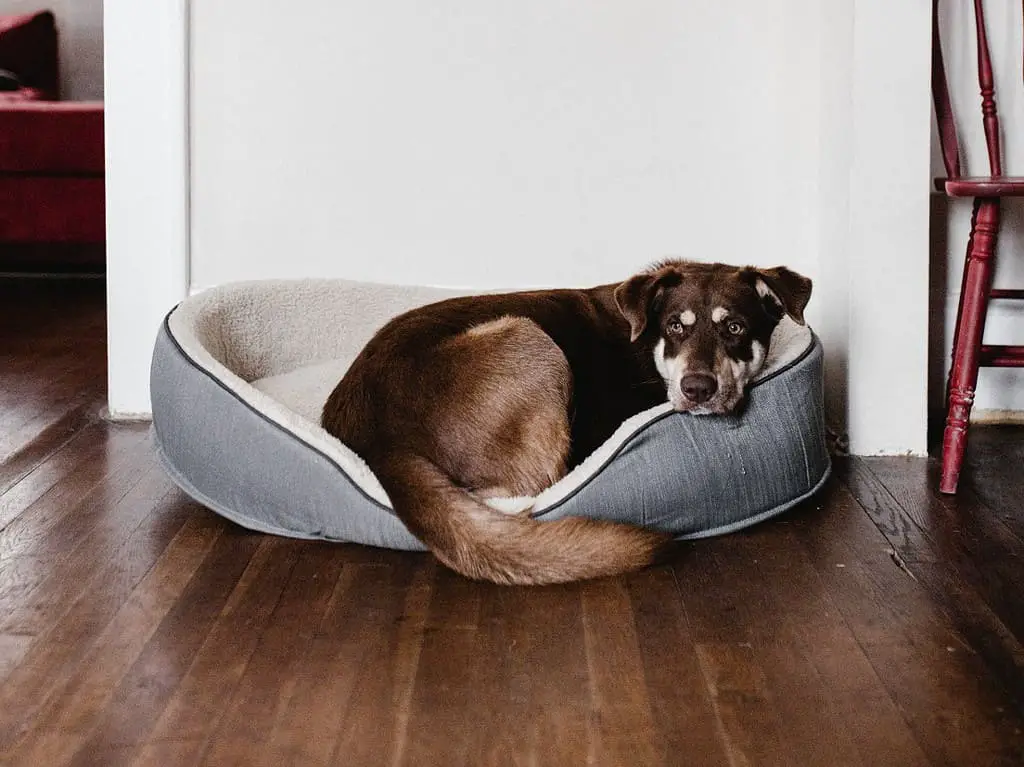Dogs are known to be erratic in terms of sleeping habits. From balling up on the couch to covering a large portion of the bed, you never quite know where your furry friend might end up.
But a common favorite among pets for sleeping is between their owners’ legs. While it may seem like an inconvenience at times, there are actually several reasons why your dog chooses this spot as their sleeping sanctuary.
So are you tired of feeling like a human sandwich every night? Do you wonder why your dog sleeps between your legs and what can be done to stop this habit? If yes, keep on reading.

Why Do Dogs Love Sleeping Between Your Legs
Read on to understand why your dog can’t resist snuggling up close.
1. Familiarity and scent: Dogs have a highly developed sense of smell and are sensitive to their owner’s scent.
A dog’s familiarity with its owner and the ability to detect scents attributed to them greatly influences why they often sleep between their legs. Dogs possess remarkable olfactory capabilities that exceed human standards, thus allowing them to identify smells accurately and in impressive detail.
When a dog sleeps between your legs, they are near your scent. They recognize when alterations in an owner’s natural scent due to changes in their emotional state – joy, distress, fear, sadness – influence the human’s body chemistry. As such, sleeping with a pup between one’s legs allows one to be privy to these nuances of scent associated with numerous mental states or conditions.
For dogs, the scent is a powerful source of information and comfort. Here’s how it relates to a dog’s decision to sleep between your legs:
Identification
Canines connect with their guardians and often rely on scent to distinguish them. By placing themselves between the legs of owners while they sleep, canines are in direct physical contact with their odor which offers both assurance and recognition. This promotes an intimate relationship with their caretaker while simultaneously comforting them.
Comfort and Reassurance
Human scents can have a calming effect on dogs. Your unique odor can provide a sense of tranquility and contentment for dogs. The familiar aroma associated with their owners, containing the sentiments of assurance, companionship, and vigilance, can encourage a relaxing atmosphere for them to sleep in. This proximity grants your pooch an opportunity to rest peacefully beneath you.
It’s worth noting that dogs can recognize the scent of other individuals with whom they have a close relationship, such as family members and good friends. Typically, however, dogs may form an even more distinct bond with their primary owner, enabling them to recognize their particular scent quickly.
2. Warmth: Your body heat is comforting.
One possible reason why your dog sleeps between your legs is the warmth those legs provide. That’s right, your dog is using you as their heating pad.
Being warm-blooded mammals, dogs rely on their body temperature for optimum health and wellness. During colder temperatures like nighttime and winter, dogs can experience decreased body warmth. Sleeping between an owner’s legs can benefit these circumstances as it provides comfort and maintains bodily warmth with the heat leaving lower extremities.
But which dog breeds are most likely to snuggle up in this way?
Chihuahua
Chihuahuas are first on the list of dogs that love sleeping between your legs. Yes, Chihuahuas are more susceptible to cold temperatures than bigger dogs due to their thin coat and small size. Though originating from warmer climates, like Mexico, they are not naturally adapted to colder environments.
Greyhound
Greyhounds possess a significantly lower proportion of body fat than other breeds and a thin layer of fur that is inadequate to protect them from low temperatures. Since body fat serves as animal insulation, which helps preserve heat and maintain warmth, Greyhounds’ lack thereof causes them to be more exposed and vulnerable to cold climates due to their biological makeup.
Additionally, Greyhounds have a short, thin coat that provides little insulation against colder weather. And even though these dogs have some fur coverage on the exterior of the body, it does not adequately compare with other dogs that typically handle cooler conditions better.
Dachshund
Also called wiener dogs or sausage dogs, Dachshunds are small dogs with a unique body shape characterized by a long torso and short legs. This physical structure is one of the reasons why they may be more prone to feeling cold compared to other breeds.
These dogs have a significantly shorter stature, bringing their bodies closer to the ground than many other dog breeds. This position places them in contact with cooler surfaces like air or the ground itself, causing them to be more prone to losing body heat.
Additionally, due to their short hair and minimal undercoat providing insulation, these breeds lack the same level of protection and warmth against cold temperatures found in other dog breeds with thicker coats.
Shih Tzu
Shih Tzis are small dogs with a relatively low body weight. As a result of their reduced size, the ratio between the surface area to volume proportionally declines; this allows for diminished loss of body heat. Their physical build also plays its part – being compact and having short limbs permit them closer proximity to the ground where temperatures may be cooler.
This breed has a beautiful and luxurious coat, but its inability to offer insulation should not go unnoticed. Their fur is long and dense; however, they lack the necessary undercoat of hair from which other dog breeds often benefit – providing them better protection against colder climates.
But that’s not all. Shih Tzus are generally domesticated for use as a companion animals, and their frequent upkeep in temperature-regulated rooms makes them much less able to adjust to low temperatures resulting in increased sensitivity to lower temperatures.
Great Dane
Great Danes lack the furry undercoats typically found on other breeds, like Huskies or Saint Bernards, designed to insulate them from cold temperatures. They are instead equipped with a single-layer short coat that provides only minimal insulation.
French Bulldog
French Bulldogs have a unique facial structure with a short, broad skull and compressed airways. This anatomy affects their ability to regulate body temperature efficiently. Their shorter airways make it harder for them to warm or humidify the air they breathe, making them more susceptible to extreme temperatures.
Moreover, due to their brachycephalic anatomy, French Bulldogs often have reduced exercise tolerance and may tire more quickly during physical activities. Reduced exercise can lead to decreased body heat production, making them more susceptible to feeling cold.
3. Security: Dogs feel safe next to you.
Security could be the key factor driving your furry friend to snuggle up while snoozing.
Domesticated canines are born as social creatures with a strong inclination to form groups. As such, in the presence of their human family members, they will often seek out comfort and security by curling up alongside them while sleeping. By doing so, dogs are reassured that their caretaker is always nearby, granting them protection.
The desire for safety may arise from prior instants of distress or trauma that your pet has experienced before being adopted by you. Sleeping between your legs provides physical warmth, emotional comfort, and safety.
4. Bonding: Sharing a sleeping space strengthens the bond.
Dogs have evolved in companionship with humans for years and developed an emotional attachment to their masters. The act of a dog sleeping between its owner’s legs is understood as a testament to the loyalty, love, and intimacy shared between them.
Additionally, dogs are naturally inclined to form social packs just like their wild ancestors. When they cuddle up between their owners’ legs, they experience a sense of security and acceptance. This behavior demonstrates that the dog feels connected to its family and understands its role as a valued member.
5. Territory: Dogs see you as their pack leader.
While the main reason for a dog sleeping between your legs is bonding, it’s worth noting that some elements of territory and dominance can be involved. By positioning themselves between your legs, dogs may mark their presence and assert their place within the pack hierarchy. However, this behavior is not necessarily dominant and should be viewed more as them seeing you as their pack leader.
6. Anxiety: Sleeping near you eases anxiety.
Dogs, like humans, can experience anxiety, and they often exhibit different signs, including:
- aggression
- attempting to escape or hide
- excessive drooling or salivating
- house soiling
- destructive behaviors (chewing or digging)
- panting or increased respiration rate
- trembling or shaking
- excessive barking, screaming, growling, whining, or howling
- restlessness, pacing, or inability to settle down
On the other hand, the causes of anxiety in dogs are:
- age-related cognitive decline
- medical conditions or chronic pain
- changes in routine or environment
- genetic predisposition
- traumatic experience or past abuse
- and lack of socialization during the critical developmental period
Providing an anxious dog with close physical contact, such as sleeping between your legs, may stimulate their sense of security and assurance. The organization of warmth and pressure from your presence can have a soothing effect on the canine’s nervous system and create a tranquil setting for them.
7. Protection: Dogs feel like they’re guarding you.
Dogs have long been regarded as loyal protectors. They are ready to lay down their lives without a second thought in defense of those they love. It is surprising that even while asleep, dogs may sometimes feel the need to do their duty. It is not uncommon for dogs to sleep beside their owners for protection.
So if you’re wondering why your dog sleeps between your legs, here is the answer: This sleeping position allows them to rapidly respond to potentially threatening situations and intruders.
8. Sense of Familiarity and Routine: Dogs thrive on routine and familiarity.
Establishing the habit of allowing your dog to sleep between your legs can be comforting for your dog and yourself; however, it is crucial to recognize that your pet may expect this arrangement as part of their bedtime routine. Yes, dogs are heavily influenced by creating and following established routine patterns. Altering their sleeping patterns and positions can be disruptive to their emotional well-being, thereby causing a feeling of unease or distress at first.
9. You are allowing it that’s why your dog sleeps between your legs.

Many pet owners find comfort in the company of their furry friends. Particularly when a small breed dog like a Peekapoo persistently cuddles up close and nestles between an owner’s legs for nighttime slumber, denying a furry friend’s request can be difficult. Generally, if this situation arises, pet owners indulge their fluffy companions to provide security and emotional support.
But what if your pup is a giant like Bully Kutta, Cane Corso Pitbull Mix, and American Alsatian? These dogs make challenging sleeping partners as they may crush you with your weight. They’ll happily sleep between your legs or push you off the bed entirely if given half a chance. This can be uncomfortable and cause discomfort or disturbed sleep patterns.
So here’s the catch: establishing boundaries from the onset is essential for avoiding a situation where your dog takes over your space during the night. If you do not establish clear limits, they will likely assume they can sleep between your legs indefinitely.
Why You Should Stop Your Dog From Sleeping Between Your Legs
Dog owners may find allowing their pets to sleep between their legs endearing. However, there are certain circumstances where it is beneficial and advantageous to alter this behavior.
Comfort and personal space
Sharing your sleeping space with a dog can be uncomfortable, especially if you are fond of shifting positions during the nighttime. Such an arrangement can affect your sleep quality and, consequently, impact your overall health. Thus, creating a designated sleeping area for the canine companion will give you breathing room and increase the likelihood of a more revitalizing rest period.
Establishing boundaries
Provide your dog with a designated sleeping area within the home to enforce boundaries. This will demonstrate that certain spaces are restricted for humans and can help prevent potential issues, including dominance struggles or increased anxiety from separation.
Safety concerns
Sleeping with a dog can be a hazard, particularly with larger breeds. These animals may inadvertently kick or cause scratches while they sleep, harming both the pet and the owner. To avoid such occurrences, it is recommended that dogs have their own designated sleeping area distinct from wherever people are resting.
Promoting independence
By conditioning your dog to sleep independently, you can build their self-assurance and autonomy. Dogs excessively dependent on owners for security or comfort may have difficulty coping when unaccompanied or in unfamiliar settings. Promoting independent sleeping
Respect for visitors or family members
If visitors or relatives are uncomfortable with dogs at their feet, it is essential to redirect your pet’s sleeping habits. This step will ensure that everyone can interact without worries about their personal space being invaded and that all individuals feel relaxed in the environment.
Maintaining consistent routines
Establishing structured sleep habits for your dog through redirection to their appointed resting area will benefit you and them. A set bedtime gives clarity on when a routine should take place, offering a sense of stability in daily life. As routines comfort dogs, providing them with security and relieving distress, the regular sleep pattern is highly favorable for their well-being.
How To Stop Your Dog From Sleeping Between Your Legs
Here are some tips to help you train your dog to sleep elsewhere.
First, understand the reason behind the behavior.
Dogs often seek assurance and protection, potentially seeking comfort by sleeping between one’s legs. In recognizing this behavior, consider any recent changes or occurrences that may have triggered it. Comprehending the root cause can be beneficial to resolve the issue correctly.
Provide an alternative comfortable sleeping spot.

When selecting a resting location for your dog, consider their preference for comfort and warmth. To ensure that they are provided with a suitable place to sleep, establish a bed or mat in the space where you and your dog spend the most time – which may be close to your bed – and decorate this space using soft sheets or warm blankets so it feels comfortable and homely.
Dogs may become disoriented when quickly subjected to drastic changes in their environment or habits. If you want them to vacate your bed, do so gradually. Start by letting them in the corner of your room near the bed instead of banning them from doing so instantly.
Thus, it is better to slowly change the behavior that you wish to modify than to change it abruptly. For instance, if you want your dog to sleep in a different space than between your legs, start by encouraging them to sleep near your bed instead of immediately prohibiting this behavior.
Provide nighttime comfort.
If your pooch has been used to sharing a sleeping space with you, transitioning them to a new sleeping area may take some time. To help this process along, make their bed inviting and familiar by adding something that smells of you like an old shirt or blanket to it.
Establish a consistent bedtime routine.
Dogs thrive on routine, so establish a consistent bedtime routine that signals to your dog it’s time to sleep. This could include walking, feeding them their dinner, or partaking in some serene playtime together. When done regularly at a specified time each night, these activities will help your pooch make the connection between them and restful sleep. They should learn to go to their designated sleeping area as soon as they recognize the routine has started.
Use positive reinforcement.
Reward your dog when they display desired behavior, such as choosing its designated bed and oversleeping between your legs. Offer verbal praise, treats, or gentle petting to give positive reinforcement for the expected behavior. Studies have shown that dogs gravitate more towards behaviors with positive reinforcement and will be encouraged to sleep in this spot by associating rewards with it.
Avoid reinforcing the behavior.
To ensure consistent behavior from your dog, it is essential not to permit them to sleep between your legs. Redirection and consistency are needed when reinforcing this desired outcome. Utilizing verbal cues such as “bed” or “go to your spot” will help guide them toward their designated bed area. This process may take time; therefore, patience and diligence in training are essential for successfully implementing the new routine.
Be consistent.
Adhering to a consistent training regimen with your dog is absolutely vital. Be sure to encourage them to sleep in their designated bed every night rather than occasionally permitting them to sleep between your legs. Providing mixed and unclear cues can confuse your dog, making it more difficult for them to comprehend what is being asked of them.
Use physical barriers.
If your pup is drawn to sleeping between your legs, create a physical divide. To do this, utilizing a blanket or pillow will render it an uncomfortable or inaccessible spot for them to sleep in; ultimately causing them to gravitate toward another area over time.
To maintain the desired space between your dog and other areas, a baby gate or pet gate could also be used to limit access to certain home parts, such as bedrooms.
Use deterrents.
Numerous different deterrents exist to prevent your pet from sleeping in undesired places. For instance, applying aluminum foil, double-sided tape, or a specially formulated deterrent spray to beds or areas between the legs can be beneficial solutions. As this interferes with their comfort level due to its texture or odor, your dog will discover nearby areas of greater satisfaction on which to nap.
Provide ample exercise and mental stimulation.
Ensure your dog gets enough physical exercise and mental stimulation throughout the day. A tired dog is more likely to settle down and sleep peacefully in their bed rather than seek comfort between your legs. Scheduled walks, interactive games, and stimulating toys can assist with achieving a satisfying level of exhaustion.
Consider crate training.
If your furry friend needs assistance to settle into sleeping in a separate bed, crate training may be a viable solution. Crate training creates a secure atmosphere for your pup to sleep in and enforces boundaries. Incorporating treats, interactive toys, and comfortable bedding will assist in introducing the procedure step by step and turn the crate into an inviting environment over time. This can typically result in the dog desiring to retire to its own space instead of snuggling between your legs during slumber hours.
Seek professional help if needed.
If your dog experiences difficulty sleeping in the area designated for it, you may find consulting a professional dog trainer or behaviorist for assistance. Such a specialist can look into your individual circumstances and recommend customized methods and strategies for attaining successful results. Further instructions may be necessary in order to create optimal outcomes.
Our Final Thoughts On Why Your Dog Sleeps Between Your Legs
It is likely derived from a combination of factors, such as wanting to feel secure and assured in their environment, appreciating the comfort provided by your presence, and responding to an instinctual need for closeness. Whatever the reason, it’s clear that this habit is a sign of affection and trust between you and your pet.
And if you want to stop this habit altogether, remember that establishing new habits takes time and dedication. Ensure you are consistent in your approach; if your dog attempts to sleep between your legs, guide them away gently but firmly without resorting to scolding or reprimanding. By remaining consistent and incorporating a positive reinforcement training system, your dog understands the new boundaries.
References
Ogata, N. (2016). Separation anxiety in dogs: What progress has been made in our understanding of the most common behavioral problems in dogs?. Journal of Veterinary Behavior, 16, 28-35.
Rooney, N. J., Clark, C. C., & Casey, R. A. (2016). Minimizing fear and anxiety in working dogs: A review. Journal of Veterinary Behavior, 16, 53-64.




